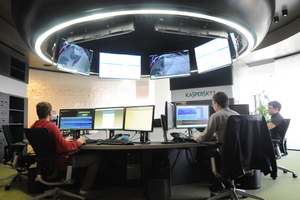WikiLeaks says CIA impersonated Kaspersky Lab

In March, WikiLeaks began publishing documentation files describing what appeared to be CIA hacking tools as part of a leak dubbed Vault 7. Roughly two dozen tools and projects were disclosed over the course of several months. Now, after a two-month break, WikiLeaks announced a new round of leaks dubbed Vault 8, which provides source code and analysis for CIA tools. The organization pointed out that, similar to Vault 7, Vault 8 will not expose any zero-day or other vulnerabilities that could be used for malicious purposes.
Read moreWikiLeaks releases files that appear to offer details of Russian surveillance system
 WikiLeaks, a secret-sharing organization accused of playing a key role in Russian attempts to influence the 2016 U.S. presidential election, has released documents that it claims offer details of how Moscow uses state surveillance to spy on Internet and cellphone users.
WikiLeaks, a secret-sharing organization accused of playing a key role in Russian attempts to influence the 2016 U.S. presidential election, has released documents that it claims offer details of how Moscow uses state surveillance to spy on Internet and cellphone users.
The release, dubbed “Spy Files Russia,” appears to mark a shift for an organization that has long been accused of a reluctance to publish documents that could be embarrassing for the Russian state. As Edward Snowden, a former National Security Agency contractor who now lives in Russia, put it in a tweet: “Plot twist.” However, other experts are less impressed.
Read moreCIA details Raytheon missile control system in docs exposed by WikiLeaks
 A missile control system developed by US defense contractor Raytheon is detailed in the CIA’s project ‘Protego,’ shared by WikiLeaks as part of the ‘Vault7’ series. WikiLeaks said the project differed to the “usual” malware development project from the CIA, with no indication as to why it’s contained within a repository of hacking techniques.
A missile control system developed by US defense contractor Raytheon is detailed in the CIA’s project ‘Protego,’ shared by WikiLeaks as part of the ‘Vault7’ series. WikiLeaks said the project differed to the “usual” malware development project from the CIA, with no indication as to why it’s contained within a repository of hacking techniques.
The release details micro-controller units which exchange data and signals over encrypted and authenticated channels, used on-board Pratt & Whitney aircraft equipped with missile launch systems. ‘Master Processor’ and ‘Deployment Box’ systems are on board the flight, with micro-controllers for the missile.
Read moreAngelfire framework used by CIA on Windows machines
 Wikileaks published another collection of files purportedly from the United States Central Intelligence Agency, the latest of which focuses on a framework used to infect machines using Windows operating systems.
Wikileaks published another collection of files purportedly from the United States Central Intelligence Agency, the latest of which focuses on a framework used to infect machines using Windows operating systems.
The release unveiled a CIA program called Angelfire, which consists of a five-part framework that can maintain a persistent backdoor on an infected machine and execute custom implants that give the agency additional access to the device. Angelfire operates in five parts, each of which allowing the intelligence agency to lodge itself deeper into an infected machine to maintain access to files and information on the targeted device.
Read moreWikiLeaks website apparently hacked by OurMine
 WikiLeaks’ website appears to have been hacked by a group called OurMine, whose previous hacks have targeted tech CEOs, companies, and news sites.
WikiLeaks’ website appears to have been hacked by a group called OurMine, whose previous hacks have targeted tech CEOs, companies, and news sites.
As of early Thursday morning, the WikiLeaks.org homepage displayed a message that read: “Hi, it’s OurMine (Security Group), don’t worry we are just testing your…. blablablab, oh wait, this is not a security test! Wikileaks, remember when you challenged us to hack you?” “Anonymous, remember when you tried to dox us with fake information for attacking wikileaks [sic]?” the message continues. “There we go! One group beat you all! #WikileaksHack lets get it trending on twitter [sic]!”
Read moreThe CIA built a fake software update system to spy on intel partners
 Anyone relying on the CIA for tech support got a nasty surprise this morning, as documents published by Wikileaks revealed a secret project to siphon out data through its technical liaison service, dating back to 2009.
Anyone relying on the CIA for tech support got a nasty surprise this morning, as documents published by Wikileaks revealed a secret project to siphon out data through its technical liaison service, dating back to 2009.
The program, called ExpressLane, is designed to be deployed alongside a biometric collection system that the CIA provides to partner agencies. In theory, those partners are agreeing to provide the CIA with access to specific biometric data — but on the off-chance those partners are holding out on them, ExpressLane gives the agency a way to take it without anyone knowing. ExpressLane masquerades as a software update.
Read moreCouchPotato: CIA hacking tool to remotely spy on video streams in real-time
 After disclosing CIA's strategies to hijack and manipulate webcams and microphones to corrupt or delete recordings, WikiLeaks has now published another Vault 7 leak, revealing CIA's ability to spy on video streams remotely in real-time.
After disclosing CIA's strategies to hijack and manipulate webcams and microphones to corrupt or delete recordings, WikiLeaks has now published another Vault 7 leak, revealing CIA's ability to spy on video streams remotely in real-time.
Dubbed 'CouchPotato,' document leaked details how the CIA agents use a remote tool to stealthy collect video streams. CouchPotato gives CIA hackers ability to "collect either the stream as a video file (AVI) or capture still images (JPG) of frames from the stream that are of significant change from a previously captured frame," a leaked CIA manual reads.
Read moreWikiLeaks reveals CIA system to take over webcams, microphones
 A new hacking tool used by the CIA has been revealed by WikiLeaks. The tool disables security cameras and corrupts recordings made on computers using Windows XP and newer versions of the Microsoft operating system. Dubbed 'Dumbo', it requires an agent to directly access a computer that holds the recordings using a USB thumb drive.
A new hacking tool used by the CIA has been revealed by WikiLeaks. The tool disables security cameras and corrupts recordings made on computers using Windows XP and newer versions of the Microsoft operating system. Dubbed 'Dumbo', it requires an agent to directly access a computer that holds the recordings using a USB thumb drive.
WikiLeaks released information about project Dumbo on its website today. WikiLeaks said: 'Dumbo can identify, control and manipulate monitoring and detection systems on a target computer running the Microsoft Windows operating system.
Read moreWikiLeaks publishes searchable archive of Macron campaign emails
 WikiLeaks said on Monday it had published a searchable archive of what it said was more than 21,000 verified emails associated with key figures in the election campaign of French President Emmanuel Macron.
WikiLeaks said on Monday it had published a searchable archive of what it said was more than 21,000 verified emails associated with key figures in the election campaign of French President Emmanuel Macron.
The stolen data was originally dumped on the internet in May, on the eve of the run-off between Macron and far-right opponent Marine Le Pen. Within hours of the leak, Macron's staff had said it had been targeted by a "massive and coordinated" hacking operation. His Republic on the Move party said the mails published by WikiLeaks seemed to be the same as the ones leaked on May 5 and warned that fake documents were mixed with authentic ones.
Read moreCIA ability to trojan Apple OS exposed in latest hacking release
 The CIA’s alleged ability to trojan an Apple OS disk image has been exposed in ‘Imperial,’ the latest release from WikiLeaks Vault 7 series. This new batch is made of three hacking exploits, ‘Achilles,’ ‘SeaPea’ and ‘Aeris.’
The CIA’s alleged ability to trojan an Apple OS disk image has been exposed in ‘Imperial,’ the latest release from WikiLeaks Vault 7 series. This new batch is made of three hacking exploits, ‘Achilles,’ ‘SeaPea’ and ‘Aeris.’
‘Achilles’ is detailed by WikiLeaks in a statement as producing one or more operators to access an OS X disk image, and execute operations one time. The OS X disk image contains the contents and structure of the device’s storage. Intel Core 2 Processor and OS X are required on the target's computer for ‘Achilles’ to operate. ‘Imperial’ is part of a series by the whistleblowers named ‘Vault 7’ which began in March and has seen releases from WikiLeaks on an almost weekly basis.
Read moreAxarhöfði 14,
110 Reykjavik, Iceland















